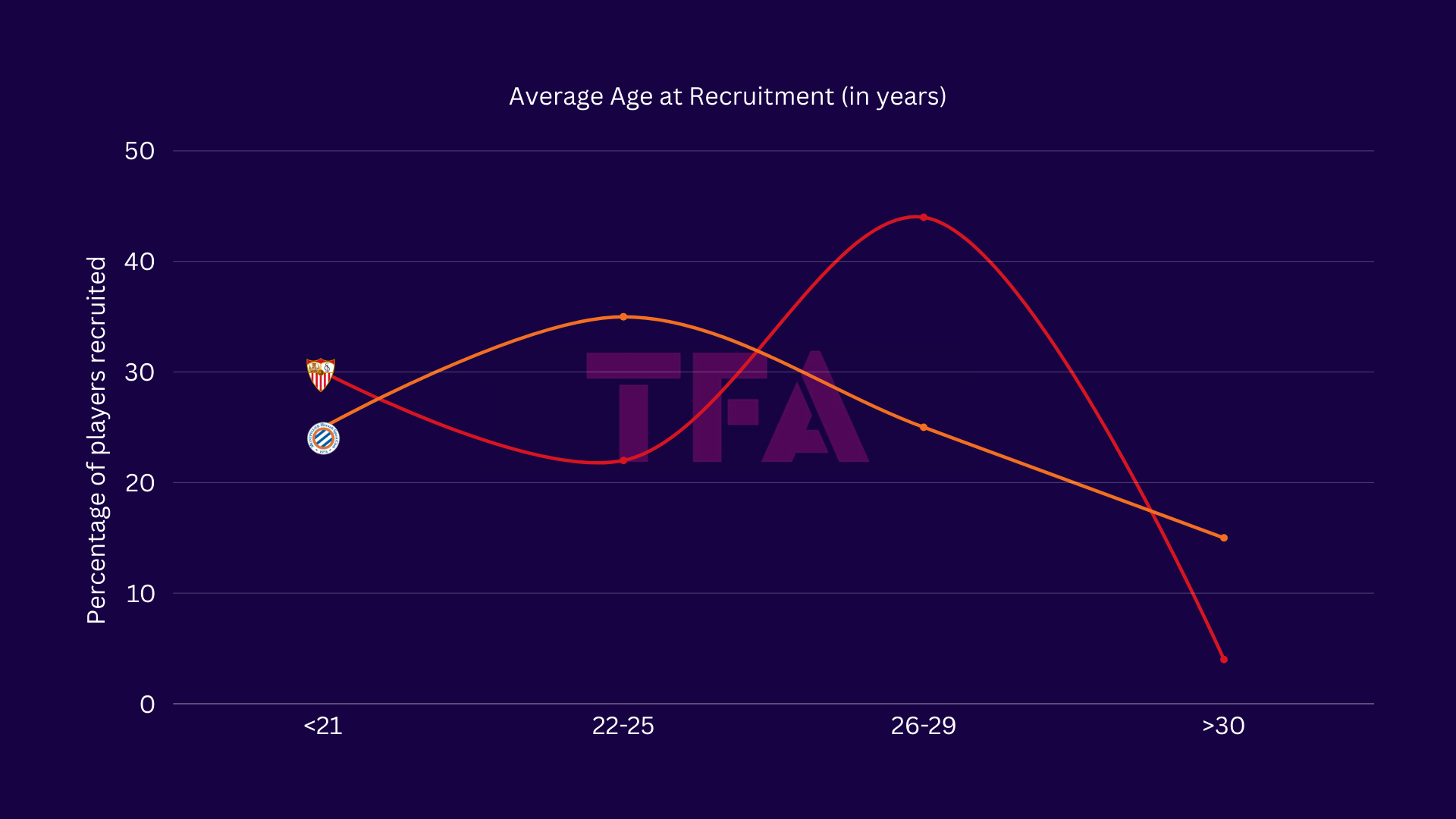Recruitment strategies vary a lot from club to club and league to league.
Aspects like financial resources, league competition, club philosophy, and ambitions all affect football clubs’ youth recruitment strategies.
This data analysis looks closely at why each club is doing what it is doing, how these strategies fit in with the clubs’ overall goals and the long-term effects on their performance and finances.
Looking at how clubs in Europe’s big five leagues recruit players shows that there are different approaches, from teams that focus on young players to teams that focus on experience.
This analysis examines recruitment data for the Premier League, Ligue 1, Austrian Bundesliga, Bundesliga and La Liga.
We will also examine the statistics behind their youth recruitment strategies and the benefits and risks involved.Building Future Stars
Some clubs, like RC Strasbourg in Ligue 1, Brentford FC in the Premier League, and RB Leipzig in the Bundesliga, have made a significant shift towards recruiting young players.
These clubs are investing in young players, often under the age of 21, because they’re betting on the long-term development of talent that could potentially bring both on-field success and financial returns through transfers.

RC Strasbourg – Average Recruitment Age: 21.8 Years
RC Strasbourg has one of the youngest squads among the Big Five leagues, with 79.2% of its players recruited under age 21.This shows they’re more focused on developing players than immediate success.
This approach fits with the club’s financial limitations, as it allows them to invest in younger, less expensive players and develop them into valuable assets.
This model means the club can make money when young players become more valuable and are snapped up by bigger clubs.
However, relying so heavily on youth does bring some inherent challenges.
Young players often lack the consistency and experience needed to perform consistently at a high level throughout an entire season.
Strasbourg’s squad is full of potential, but they might find it challenging to go against more experienced opponents.
This approach also puts a lot of pressure on the coaching and development staff, who have to ensure that young talents mature quickly and are integrated into competitive match settings.
The club, part of Chelsea FC‘s Multi-Club Ownership umbrella, is currently ranked 11th in the Austrian Bundesliga and seems to have found the right balance.
Brentford FC – Average Recruitment Age: 22.32 Years
Thomas Frank’s Brentford is one of England’s most data-driven clubs.
Brentford’s strategy involves finding undervalued young players and helping them develop within the club.
51.9% of their recruits are under 21, and another 37% are aged between 22 and 25.
Brentford’s recruitment is based on extensive scouting and analytics.
It targets players who are statistically likely to succeed but may not yet be on the radar of larger clubs.
Brentford’s strategy is to focus on young players to get the best resale value.
The club’s success in turning players like Ollie Watkins (bought for €7.22m, sold for €34m) and Neal Maupay (bought for €2m, sold for €15.56m) into profitable transfers is an excellent example of this model in action.
But like Strasbourg, Brentford must work hard to maintain competitive consistency, especially in a top league like the Premier League.
RB Leipzig – Average Recruitment Age: 22.36 Years
RB Leipzig are known for their structured development model, and their recruitment philosophy is focused on youth.
In fact, 47.8% of players were recruited under the age of 21, and another 39.1% were between 22 and 25.
Leipzig’s model is part of the broader Red Bull Group football strategy, which emphasises high-intensity pressing and rapid player development.
The MCO scouts young talents all over the world, focusing on France.
It then brings them into Salzburg’s or Leipzig’s system and often turns them into stars, like Timo Werner and Dayot Upamecano, who then move on to other top clubs.
Leipzig’s focus on youth helps keep the average wage bill down while maintaining the dynamism and energy that align with the club’s high-intensity playing style.
However, the Leipzig squad has hardly any players over 30, which shows that the club is more focused on future potential than on experience.
Building Stability While Developing Talent
Some clubs are trying a more balanced approach to recruitment.
They’re investing in young players while also bringing in talent in the 22-29 age range.
The idea is to develop young talent without losing their stability.

Chelsea FC – Average Recruitment Age: 22.54 Years
Chelsea‘s recruitment strategy has changed a lot recently.
Under the old owners, it was a “buy-now” approach.
However, the new management is more focused on developing talent.
Over half of Chelsea’s recruits are under 21, with 44% in the 22-25 age range.
The club is looking to build a young, high-potential core that can compete in the long term.
This approach is shown by signings like Enzo Fernández and Mykhailo Mudryk, players who were picked up early in their careers but who are already paying at a high level and could become world-class players.
However, there are some risks involved in Chelsea’s strategy.
The club’s youth-focused approach has been accompanied by considerable managerial turnover, which can make it harder for players to develop.
In addition, Chelsea needs to succeed in the Premier League and Champions League immediately, which puts pressure on these young players.
They’re expected to perform consistently despite their potential inexperience at the level.
Real Madrid – Average Recruitment Age: 22.66 Years
Real Madrid have always been a club that strikes a balance between star power and youth development.
Over half of the team’s players are under 21, with another 25% in the 22-25 and 26-29 age groups.
The club’s strategy is to bring in young stars who have the potential to become icons, like Vinícius Júnior, Rodrygo, and, more recently, Jude Bellingham.
However, unlike some clubs that focus on youth, Real Madrid pairs these young talents with experienced leaders, including Luka Modrić and Dani Carvajal, to maintain the balance.
This approach means that Real Madrid can maintain their competitiveness in La Liga and Europe as younger players learn from more experienced players in high-stakes situations.
The model also gives the club financial flexibility, allowing it to keep top young talents for years or sell them at a profit.
As the older players retire, the club already has successors in the squad who can handle the weight of Real Madrid’s expectations.
AS Monaco – Average Recruitment Age: 22.93 Years
AS Monaco‘s recruitment strategy is similar to Leipzig’s, with a focus on young players.
However, a significant proportion (44.4%) are aged between 22 and 25.
Monaco have an excellent track record when it comes to developing players.
The club has produced some top players, like Kylian Mbappé and Thomas Lemar, who were eventually sold for big transfer fees.
This approach helps Monaco stay competitive in Ligue 1 while also generating revenue from player sales.
By mixing young players with a few older ones, Monaco ensures that its team is competitive while maintaining its value.
However, this strategy can sometimes result in periods of inconsistency, as the club often sells its best players at the height of their development.
Stability Through Experience
Some other clubs, like FC Bayern and Borussia Dortmund in the Bundesliga and Arsenal in the Premier League, have a higher proportion of players in the 26-29 age bracket.
They’re looking for stability and experience that can drive immediate success.

FC Bayern – Average Recruitment Age: 24.28 Years
Bayern’s recruitment strategy shows that they’re looking for players who are ready to compete at the highest level from day one of their careers.
Many of the players are in the 26-29 age group (28.6%), and Bayern is looking for players who can bring experience and make an immediate impact.
This is important because they’re always trying to win the Bundesliga and the Champions League.
Signings like Michael Olise and Harry Kane show this focus on reliability.
Bayern’s approach offers stability, leadership and tactical reliability, which is particularly valuable in high-stakes European matches.
On the other hand, Bayern could end up with an ageing squad and high wage bills.
The trick is to gradually bring in younger talent from their academy or scouting network to avoid relying too heavily on older stars like Manuel Neuer and Thomas Müller.
Borussia Dortmund – Average Recruitment Age: 24.86 Years
Borussia Dortmund has traditionally been known for developing young players, but it has recently shifted to a more balanced recruitment model.
While they still recruit talent under 21 (21.1%), they’re also bringing in more players in the 22-25 and 26-29 age groups.
This change shows that Dortmund want to compete with Bayern Munich, Bayer Leverkusen and RB Leipzig in domestic competitions while still doing well in the Champions League.
By mixing youth with experience, Dortmund are trying to avoid the inconsistency that comes with a young squad.
However, Dortmund have struggled to keep their young talent, with many players, such as Jadon Sancho and Jude Bellingham, eventually leaving for bigger clubs.
It’s vital for Dortmund to find a way to develop young talent while keeping their experienced players on board and finally perform consistently in both domestic and international competitions.
Arsenal FC – Average Recruitment Age: 24.83 Years
Arsenal have recently made some significant changes to its recruitment strategy, focusing on younger players under manager Mikel Arteta’s tactics.
While the club has plenty of players under 25, they’ve also brought in more experienced players like Gabriel Jesus and Jorginho to provide stability and experience.
Arsenal’s recruitment in the 26-29 age range (26.1%) shows they’re looking to combine long-term potential with immediate leadership.
This mix has given Arsenal a new lease of life and made them serious title contenders in the Premier League.
To keep this up, though, they’ll need to have a good long-term plan in place.
Arsenal needs to monitor young talent while keeping hold of or replacing experienced players without disrupting the team—a big task for the next sporting director after Edu left earlier this month.
Experience Over Development
The last group of clubs, like Sevilla FC in La Liga and Montpellier HSC in Ligue 1, focus on recruiting experienced players, many of whom are in the 26-29 and 30+ age brackets.
The idea is to ensure the team plays well and doesn’t take unnecessary risks in important matches.

Sevilla FC – Average Recruitment Age: 25.2 Years
Sevilla have many players in the 26-29 and 30+ age brackets, which shows that they’re focused on stability and experience, especially in European matches.
This approach has brought success in the UEFA Europa League, where Sevilla’s disciplined and experienced squad really shined in the last 10 years.
While this approach gets results in the short term, it limits Sevilla’s resale potential and can lead to an ageing squad, which means costly replacements.
Montpellier HSC – Average Recruitment Age: 25.45 Years
Montpellier HSC‘s squad is one of the oldest in Ligue 1, with 25% of their players in the 26-29 and 30+ age brackets.
This focus on maturity is a reflection of Montpellier’s need for consistency in a competitive Ligue 1.
Montpellier’s reliance on experienced players helps them maintain stability.
Montpellier’s experienced squad provides resilience, but there’s a risk of stagnation as older players may lack the dynamism of younger opponents in France, one of the countries with the biggest talent.
Montpellier must strike a balance between this approach and making the odd youth investment to stay competitive in the future.
Conclusion
The different recruitment strategies used by clubs in Europe’s big five leagues reflect their individual goals, financial situations and competitive pressures.
Each club’s recruitment strategy is a calculated risk that aligns with their philosophies and ambitions.
Either way, these strategies show just how complex and multi-dimensional modern football recruitment is.





Comments